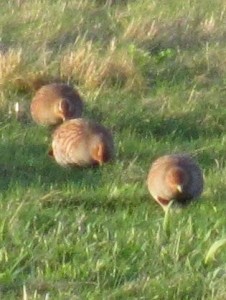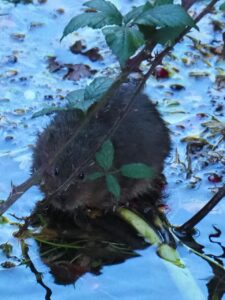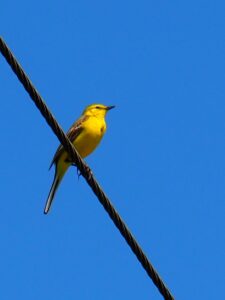For the last twelve years I have surveyed breeding populations of farmland birds on a square kilometre of green belt on the southern fringe of Cambridge, to assess the levels of the biodiversity of an area close to the city. I have written a book about my study, entitled A haven for farmland birds.
Over the twelve years I have in total recorded 105 bird species, of which 51 have bred.  These include 18 of the 19 farmland bird indicator species, of which 15 have bred, and 22 red list species of high conservation concern, of which 12 have bred. My most recent survey of the area – which you can download below – showed high numbers of grey partridge (right) and corn bunting (below left), as well as skylark, linnet, yellowhammer (below centre) and yellow wagtail (below right). Grey partridge declined by 93% between 1970 and 2018 and corn bunting by 89% while yellow wagtail declined by 68%, skylark by 60%, yellowhammer by 56% and linnet by 55%. Lapwing also attempted to breed, probably without success.
These include 18 of the 19 farmland bird indicator species, of which 15 have bred, and 22 red list species of high conservation concern, of which 12 have bred. My most recent survey of the area – which you can download below – showed high numbers of grey partridge (right) and corn bunting (below left), as well as skylark, linnet, yellowhammer (below centre) and yellow wagtail (below right). Grey partridge declined by 93% between 1970 and 2018 and corn bunting by 89% while yellow wagtail declined by 68%, skylark by 60%, yellowhammer by 56% and linnet by 55%. Lapwing also attempted to breed, probably without success.
In 2023 the area supported a grey partridge population of at least 12 spring pairs/km2 and around 72 birds/km2 in autumn. The arable farms typical of Cambridgeshire support between 0 and 5 pairs/km2 and 0–20 birds/km2 in the autumn. However numbers are lower than the 18 pairs and 90+ birds in 2021, suggesting that the continued expansion of the Biomedical Campus may be forcing the birds into a smaller area away from the development.
Corn buntings held 8 territories. This is an important population – there are just 11,000 pairs in the UK and its recent extinction in Ireland risks being repeated in large parts of Britain if its breeding sites are not protected. Nonetheless numbers are lower than the 11 territories in recent years, probably because of the work on the railway line connected with the new Cambridge South Station. Let us hope this is a temporary issue.
 In addition, the site supports thriving populations of water voles – in Hobsons Brook and the ditch that runs alongside the cycle path – and at least 20 brown hare.
In addition, the site supports thriving populations of water voles – in Hobsons Brook and the ditch that runs alongside the cycle path – and at least 20 brown hare.
I also survey butterfly and dragonfly populations in the area; the 25 species of butterfly I have recorded include brown argus (below left), clouded yellow, small copper (below centre) and small heath (below right).
You can download a copy of my report for 2023 here:
The local plan
The area I study is currently green belt. However the local councils have already released the two fields closest to the Biomedical Campus for development, and one of these has already been built on. In the next local plan the councils are likely to propose releasing two further fields from green belt for development, and this would have a negative impact on the farmland birds that live there.
At the moment the local plan is on hold ‘due to continued work exploring water supply, and delay to the submission of the Cambridge Waste Water Treatment Plant relocation’. However a further consultation will take place at some point – I will give links to it here and you can sign up for updates from Greater Cambridge Planning. In the meantime you can raise the issue with your local councillors and read/download my response to the previous consultation here:
Past reports
My report for 2022 is here:
My report for 2021 is here:
My report for 2020 is here:
My report for 2019 is here:
My report for 2018 is here:
My report for 2017 is here:
My reports for 2016 are here:
My reports for 2015 are here:






